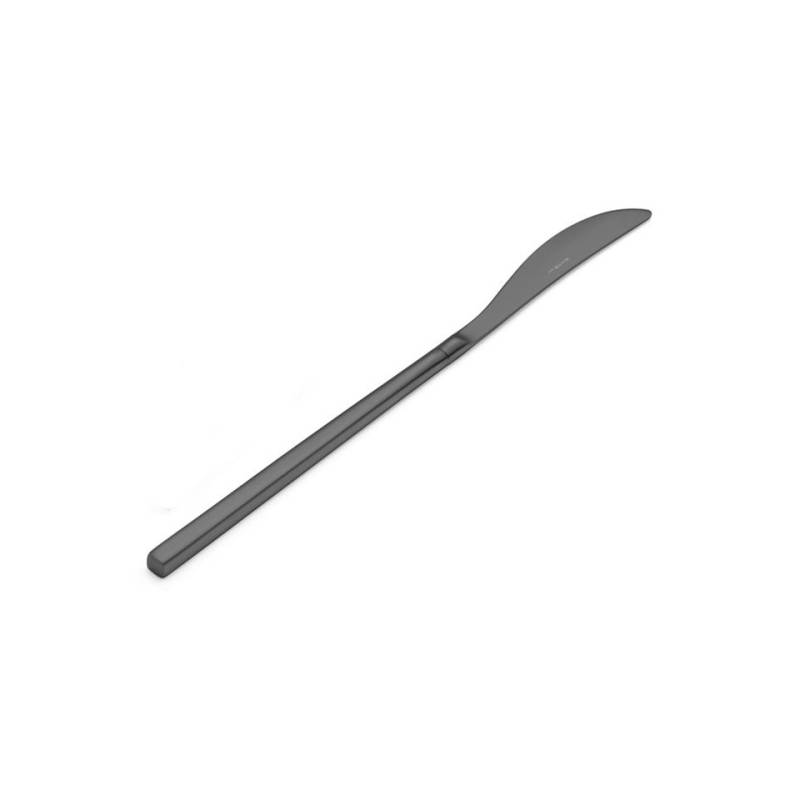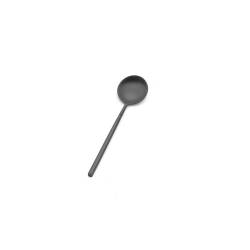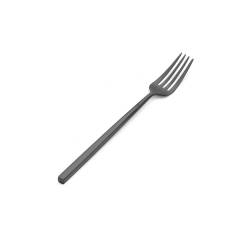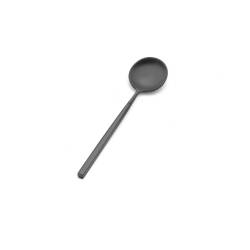Das Kyoto-Tischmesser aus schwarzem, sandgestrahltem, geschmiedetem Stahl (22,9 cm) ist Teil einer begehrten und hochmodernen Eme-Besteckserie, die zu den kühnsten Inszenierungen passt.
KYOTO SANDGESTRAHLTES SCHWARZES TISCHMESSER AUS GESCHMIEDETEM STAHL: MERKMALE
Die Linie Kyoto Sandblasted Black symbolisiert die elegante Nüchternheit des Wesentlichen. Diese vollständig recycelbare Kollektion geschmiedeter Bestecke im perfekten japanischen Stil besteht aus rostfreiem Stahl 18/10 mit einer eleganten sandgestrahlten, mattschwarzen PVD-Beschichtung. Die Messer werden speziell aus gehärtetem martensitischem Stahl (AISI 420) hergestellt, der die Schärfe der Klinge dauerhaft gewährleistet.Die sandgestrahlte Oberfläche, die sich durch eine geringe Rauheit auszeichnet, wird durch die Technik des Mikroperlenstrahlens erzielt, einer Oberflächenbehandlung des Stahls, die kalt mit unter Druck geschossenen keramischen Mikrokugeln durchgeführt wird. Das Objekt erhält eine besondere ästhetische Wirkung durch das reflektierte Licht, das von der Oberfläche gestreut wird.
PVD steht für Physical Vapor Deposition (Physikalische Gasphasenabscheidung). Dabei handelt es sich um eine Technologie zur Färbung von Stahl durch die Abscheidung sehr dünner Metallschichten in Vakuumkammern, die aus der Verdampfung und anschließenden Kondensation der Metalle auf dem Besteck besteht. Diese Behandlung mit einer Reihe wunderbarer Farbnuancen verschönert nicht nur das Besteck, sondern macht es auch widerstandsfähiger gegen Abnutzung und Kratzer und ist eine vollkommen nachhaltige Beschichtung, die für die Verwendung in der Lebensmittelindustrie geeignet ist.
Das Hauptmerkmal dieser Linie ist die Einfachheit des Designs, das ikonisch und fast kindlich ist. Das Design wurde um die Idee der Reinheit herum entwickelt, das Gleichgewicht zwischen der Leichtigkeit des Griffs und der Rundheit der Produkte.
Die neutrale Form, die niemals banal ist, wird durch das Detail des eingravierten Rings hervorgehoben, der den Mittelpunkt zwischen dem quadratischen Griff und dem konischen Teil des Besteckhalses bildet. Es ist dieses unterbrechende Element, das weitere Farb- und Ausführungskombinationen zulässt und es dem Unternehmen ermöglicht, eine möglichst große Anzahl von Benutzern zufrieden zu stellen.
Messer aus rostfreiem Stahl AISI 420 sind anfälliger für Korrosion.
Es wird empfohlen, Rückstände von Salz, Essig, Zitronen- und Tomatensaucen zu entfernen.
Achten Sie auch auf Spülmaschinensalz, das eine korrosive Wirkung haben kann. Nachdem Sie das Salz in den Tank geschüttet und die Reste mit einem feuchten Tuch abgewischt haben, sollten Sie einen Vakuumwaschgang durchführen, um die Salzreste zu entfernen, die sonst das Stahlbesteck während des Waschgangs beschädigen könnten.
TAFELMESSER AUS SCHWARZEM, SANDGESTRAHLTEM SCHMIEDESTAHL: MÖGLICHE ROSTFLECKEN
EME-Bestecke (Löffel, Schöpflöffel, Gabeln, Schöpfkellen usw.) werden im Wesentlichen aus zwei verschiedenen Arten von Stahllegierungen hergestellt:AISI*304 - austenitischer Stahl, gemeinhin 18/10 genannt
AISI*430 - ferritischer Stahl, gemeinhin als 18/C bezeichnet
EME-MESSER werden ausschließlich aus der folgenden Legierungsart hergestellt:
AISI*420 - härtbarer Stahl
In der Zusammensetzung des Stahls 18/10 für die Herstellung von Besteck kann ein gewisser Prozentsatz an Nickel enthalten sein, während dieser bei der Herstellung von Messern völlig fehlt. Er ist der einzige härtbare Stahl und verbessert durch diese Wärmebehandlung seine mechanischen Eigenschaften, die z. B. die Schärfe von Messerklingen ermöglichen. Beide Arten können NICHT rosten, wenn mit Rost Eisenoxid gemeint ist. Im Laufe der Zeit können jedoch dunkle und/oder rostige Flecken auf den Oberflächen entstehen, die durch äußere Verunreinigungen des Bestecks verursacht werden und nicht durch einen tatsächlichen Angriff auf den rostfreien Stahl. Die häufigsten Ursachen für die Entstehung dieser Flecken sind das Reiben des Bestecks mit Stahlwollepads, der Kontakt mit Eisen-/Stahlgegenständen oder die Verunreinigung mit Wasser, das einen hohen Gehalt an gelöstem Eisen aufweist. Diese Flecken lassen sich jedoch leicht mit einem Stahlreinigungsmittel entfernen. Kleine Rostflecken können sich auch auf Messerklingen bilden, insbesondere nach dem Spülen in der Spülmaschine.
*Amerikanisches Institut für Eisen und Stahl (AISI)
KYOTO SCHWARZ SANDGESTRAHLTES TISCHMESSER AUS GESCHMIEDETEM STAHL: MÖGLICHE URSACHEN FÜR OXIDATION
Hier sind die möglichen Ursachen für die Oxidation dieses Messertyps:- Elektrische Entladung in der Spülmaschine
Alle Geschirrspülmaschinen, ob für den privaten oder den gewerblichen Gebrauch, erzeugen während der Spülzyklen kleine elektrische Entladungen im Inneren, die normalerweise Porzellan, Gläser und Besteck (Löffel, Gabeln usw.) nicht beeinträchtigen. Das Einbringen von verzinkten, verzinnten (Backutensilien) oder aus Aluminium gefertigten Gegenständen (Töpfe und Pfannen oder Deckel) verstärkt die Bildung dieser kleinen Entladungen, die aufgrund der oben beschriebenen Zusammensetzung der Stahllegierung ausschließlich von den Messerklingen angezogen werden.
Dieses Phänomen kann auch beim gleichzeitigen Einbringen von Messern und Porzellanartikeln mit wichtigen Verzierungen in die Spülmaschine auftreten; die Zusammensetzung der Porzellanfärbung verursacht nämlich einen ähnlichen Effekt wie Aluminium und
kann Messerklingen beschädigen.
Die in den ersten Episoden entstehenden Flecken sind nicht sehr korrosiv und es ist ratsam, sie mit einem Schwamm und einem neutralen Reinigungsmittel zu entfernen, damit das Problem nicht größer wird.
- Chlordioxid im Trinkwasser
Seit einigen Jahren wird Chlordioxid (ClO2) als Desinfektionsmittel im Trinkwasser anstelle von Natriumhypochlorit (Bleiche - NaClO) oder Chlorgas verwendet.
Obwohl Chlordioxid in Bezug auf die Desinfektion wirksamer ist, da es 5 Mal wirksamer ist als Chlorgas, gibt es Gegenanzeigen bei der Verwendung bei Temperaturen
hohe Temperaturen über 60 Grad, z. B. während eines Spülmaschinenzyklus. Bei dieser Temperatur besteht die Tendenz zur Bildung von Chlorsäure (HClO2), die die martensitischen Stähle von Besteck angreift.
Dieses Phänomen ist so ausgeprägt, dass bereits beim ersten Waschen neuer Werkstücke in der Spülmaschine Korrosionserscheinungen auf den Klingen und Messern auftreten können, die als Grubenkorrosion bezeichnet werden, d. h. als kleine Rostflecken, die sich zwangsläufig vergrößern werden.
Um das Problem so gering wie möglich zu halten, muss die Zeit, in der die Dämpfe mit den Messern in Berührung kommen, begrenzt werden. Deshalb müssen die Messer nach dem Spülen aus der Spülmaschine genommen und mit einem weichen Tuch abgewischt werden, ebenso wie die Teile, die trocken erscheinen.
Für gewerbliche Nutzer, Restaurants, Kantinen, Mensen, Gemeinden empfehlen wir die Installation eines Entchlorers vor dem Spülsystem, der die Menge an aktivem Chlor im Wasser deutlich reduziert.
- Wartung und/oder externe Verschmutzung
Die Ursachen für die Oxidation sind immer extern, nämlich durch unsachgemäße Wartung oder Verschmutzung.
Edelstahl kann durch die Einwirkung starker Säuren wie Schwefelsäure und Natriumchlorid oder durch in Lebensmitteln enthaltene Substanzen oxidieren, die einen korrosiven Prozess auf seinen Oberflächen auslösen, wie Essigsäure, Zitronensäure, Milchsäure usw.
KYOTO-TISCHMESSER AUS GESCHMIEDETEM, SCHWARZEM SANDGESTRAHLTEM STAHL: TÄGLICHE PFLEGEHINWEISE
Abschließend noch einige Hinweise zur täglichen Pflege des Kyoto-Tischmessers Sandgestrahlt Schwarz Eme:- Waschen Sie das Besteck nach dem Gebrauch gut ab und lassen Sie es nie über längere Zeit schmutzig.
- Vermeiden Sie die Verwendung von Scheuermitteln, die Kratzer auf der Oberfläche von Stahlprodukten verursachen können.
- Lassen Sie das Besteck nie für längere Zeit im Wasser liegen.
- Spülen Sie alle Teile mit Wasser ab, bevor Sie sie in den Korb der Spülmaschine legen.
- Legen Sie die Messer mit der Klinge nach unten ein.
- Nehmen Sie das Besteck am Ende des Spülprogramms so schnell wie möglich heraus und trocknen Sie es gegebenenfalls ab; wenn dies nicht möglich ist, öffnen Sie die Tür des Geschirrspülers, damit der Dampf entweichen kann und sich keine Feuchtigkeit ansammelt.
- Verwenden Sie nur hochwertige Reinigungsmittel und halten Sie sich an die Anweisungen auf der Packung, damit Sie immer die besten Ergebnisse erzielen.
- Überprüfen Sie stets die Zusammensetzung der in den Geschirrspüler eingebrachten Gegenstände.
- Befolgen Sie immer die Anweisungen in der Bedienungsanleitung des Geschirrspülers.
Wenn Sie Hilfe bei Bestellungen, Rücksendungen oder Lieferungen benötigen, klicken Sie hier.
Wenn Sie mehr über dieses Produkt wissen möchten, aber die gesuchte Antwort nicht in der Beschreibung gefunden haben, stellen Sie Ihre Frage hier und wir werden uns so schnell wie möglich bei Ihnen melden.
Sie müssen registriert sein, um auf diese Funktion zugreifen zu können. Login




